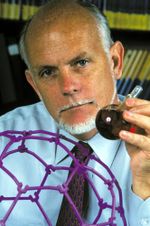No offense, but this is a bigger win than the East Carolina game.
A team under James Tour, who now heads the Rice Carbon Nanotechnology Lab, appears to have succeeded in growing carbon nanotubes from "seed" tubes.
A paper on all this will go into the Journal of the American Chemical Society.
Dr. Tour (right) is listed as "lead corresponding author" on the final paper because it continues work started by the late Dr. Richard Smalley, the 1996 Nobel Prize winner in Chemistry who passed away last year. Dr. Smalley had long been working on creating commercial quantities of nanotubes for industry, and even invented a manufacturing technology for tubes involving carbon monoxide.
In writing of this latest discovery, Tour warns against over-exuberance. So far the team has only shown that the new tubes are longer and of the same internal dimensions as the seeds. They must still be tested to show that they are chemically identical to the original seeds. Smalley’s earlier manufacturing processes resulted in a variety of up to 80 different nanotubes being produced — he wasn’t replicating specific tubes with specific properties in mass quantities.
But now the team may have cracked that case.
In the e
wrapper that let them be placed on a silicon oxide substrate. The whole
thing was then put into a furnace and, with iron acting as a catalyst,
the seeds grew to over 30 times their original length.
Tour’s group has been best known until now for its work on nanocars, machines built on a nanoscale. Tour, who is originally a Syracuse grad (go Orange) came to Rice in 1999.
According to Azonano, the big news here was the team’s ability to "cut" tubes into seeds in the first place. The technology goes by the name Single Wall NanoTube Amplification.











